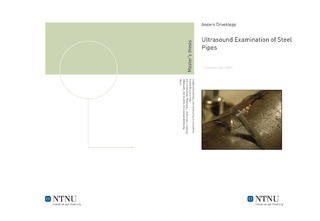Ultrasound Examination of Steel Pipes
Master thesis
Permanent lenke
http://hdl.handle.net/11250/2369322Utgivelsesdato
2007Metadata
Vis full innførselSamlinger
Sammendrag
Non-intrusive testing of pipelines has become a growing industry, and is expected to keep growing as the demands on quality control and safety keep increasing. In order to meet the oil industry s demands for pipe monitoring of sub sea pipelines, the SmartPipe project was initiated by SINTEF in Trondheim, Norway. One of the primary objectives of the SmartPipe project is develop a system for in-service monitoring of the pipelines that are placed on the seabed by the offshore oil industry. This thesis presents a very early step in the research required for the development of such a system. The purpose of the presented work was to carry out introductory experimental work in order to find out whether it is possible to develop relatively simple techniques for in-service testing of sub sea steel pipes. A so-called pitch-catch setup and various wedges was used in order to test the area between a pair of 5 MHz ultrasound transducers. Measuring over a distance of 1.00 m, rather than just single points on the pipe, could provide more general information about the condition of the pipe. Tests with over 4 m distance between transducers were also carried out. Measurement stability and mechanical coupling are of crucial importance in ultrasonic test systems, and useful knowledge on the subjects has been gained and are documented in this thesis. Results from measurements indicate that comprehensible results can be attained even with very simple measurement setups. Especially when using special wedges for introduction of Rayleigh waves, the received signals had high amplitudes and the signal envelope had a simple shape. The effect that the damage to the pipe had on the Rayleigh waves, was found to be equally simple and predictable. Shear waves and longitudinal waves that are less sensitive to the surrounding medium, were also shown to be applicable in flaw detection. Results and discussion include both time domain, frequency domain and energy considerations.
